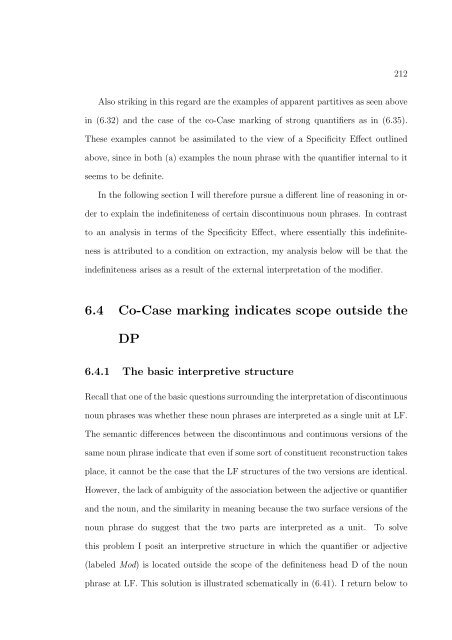the syntax and semantics of relativization and quantification
the syntax and semantics of relativization and quantification
the syntax and semantics of relativization and quantification
You also want an ePaper? Increase the reach of your titles
YUMPU automatically turns print PDFs into web optimized ePapers that Google loves.
212<br />
Also striking in this regard are <strong>the</strong> examples <strong>of</strong> apparent partitives as seen above<br />
in (6.32) <strong>and</strong> <strong>the</strong> case <strong>of</strong> <strong>the</strong> co-Case marking <strong>of</strong> strong quantifiers as in (6.35).<br />
These examples cannot be assimilated to <strong>the</strong> view <strong>of</strong> a Specificity Effect outlined<br />
above, since in both (a) examples <strong>the</strong> noun phrase with <strong>the</strong> quantifier internal to it<br />
seems to be definite.<br />
In <strong>the</strong> following section I will <strong>the</strong>refore pursue a different line <strong>of</strong> reasoning in order<br />
to explain <strong>the</strong> indefiniteness <strong>of</strong> certain discontinuous noun phrases. In contrast<br />
to an analysis in terms <strong>of</strong> <strong>the</strong> Specificity Effect, where essentially this indefiniteness<br />
is attributed to a condition on extraction, my analysis below will be that <strong>the</strong><br />
indefiniteness arises as a result <strong>of</strong> <strong>the</strong> external interpretation <strong>of</strong> <strong>the</strong> modifier.<br />
6.4 Co-Case marking indicates scope outside <strong>the</strong><br />
DP<br />
6.4.1 The basic interpretive structure<br />
Recall that one <strong>of</strong> <strong>the</strong> basic questions surrounding <strong>the</strong> interpretation <strong>of</strong> discontinuous<br />
noun phrases was whe<strong>the</strong>r <strong>the</strong>se noun phrases are interpreted as a single unit at LF.<br />
The semantic differences between <strong>the</strong> discontinuous <strong>and</strong> continuous versions <strong>of</strong> <strong>the</strong><br />
same noun phrase indicate that even if some sort <strong>of</strong> constituent reconstruction takes<br />
place, it cannot be <strong>the</strong> case that <strong>the</strong> LF structures <strong>of</strong> <strong>the</strong> two versions are identical.<br />
However, <strong>the</strong> lack <strong>of</strong> ambiguity <strong>of</strong> <strong>the</strong> association between <strong>the</strong> adjective or quantifier<br />
<strong>and</strong> <strong>the</strong> noun, <strong>and</strong> <strong>the</strong> similarity in meaning because <strong>the</strong> two surface versions <strong>of</strong> <strong>the</strong><br />
noun phrase do suggest that <strong>the</strong> two parts are interpreted as a unit. To solve<br />
this problem I posit an interpretive structure in which <strong>the</strong> quantifier or adjective<br />
(labeled Mod) is located outside <strong>the</strong> scope <strong>of</strong> <strong>the</strong> definiteness head D <strong>of</strong> <strong>the</strong> noun<br />
phrase at LF. This solution is illustrated schematically in (6.41). I return below to
















